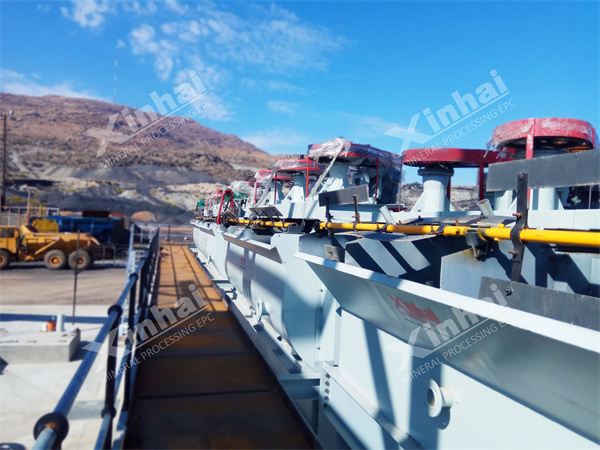In the world of mineral resources, zinc oxide, as an important zinc containing mineral resource, has significant value that cannot be ignored. The main zinc containing minerals of zinc oxide include sphalerite, xenolite, etc. These minerals exist in various forms, mostly in block, granular, or fibrous forms. The coexisting gangue minerals include quartz, feldspar, mica, etc., and the presence of these gangue minerals poses certain challenges to the selection of zinc oxide.
Flotation is one of the main methods for selecting zinc oxide. Currently, common methods include sulfide amine flotation, sulfide xanthate flotation, direct fatty acid flotation, and flocculation flotation.

Sulfide amine flotation is a method that first uses a sulfurizing agent (usually sodium sulfide) to pre sulfurize zinc oxide ore, and then uses a fatty amine collector for selection. During this process, sodium sulfide reacts with the surface of zinc oxide minerals, causing changes in their surface properties and creating conditions for the subsequent action of fatty amine collectors.
However, this method also has some limitations. It is sensitive to mineral mud and soluble salts, which leads to high consumption of chemicals and high selection costs in actual production. Meanwhile, this method is not suitable for processing ores containing large amounts of mica, chlorite, shale, sericite, or carbonaceous shale. Because during the flotation process, these gangue minerals are prone to float up together with zinc oxide ore, thereby reducing the quality of zinc concentrate. For example, in a certain zinc oxide mine, due to the high content of minerals such as mica in the ore, although the sulfide amine flotation method can recover some zinc oxide minerals to a certain extent, the quality of zinc concentrate is difficult to meet ideal requirements due to the interference of gangue minerals, and the cost of reagents is also high.
Sulfurization yellow medicine flotation also requires pre sulfurization of zinc oxide ore with sodium sulfide. On this basis, it is necessary to add copper sulfate for further activation, and then use advanced yellow medicine for collection. This method may require heating in some cases to achieve better flotation results. However, the large amount of copper sulfate not only increases the cost of mineral processing, but also faces many difficulties when applied on a large scale in industry.
For example, a certain beneficiation plant had to use a large amount of copper sulfate for activation in order to achieve better flotation indicators when using the sulfide xanthate flotation method. However, this not only leads to a significant increase in costs, but also generates a large amount of copper containing wastewater that requires additional treatment, increasing environmental pressure. Moreover, the heating process also requires a large amount of energy consumption, further increasing production costs.
Fatty acid direct flotation is the direct separation of zinc oxide ore using fatty acid collectors. Its main feature is that it has a good flotation effect on zinc oxide ores containing siliceous and argillaceous gangue. However, this method is not suitable for processing carbonate vein minerals and zinc oxide ores with high iron content. The main reason why it has not been widely used in industry is the poor selectivity of the collector.
For example, in some zinc oxide mines with a high content of siliceous and muddy gangue, direct flotation of fatty acids can achieve certain results. However, when dealing with ores containing carbonate vein minerals or high iron content, the insufficient selectivity of collectors for different minerals makes it difficult to improve the grade and recovery rate of zinc concentrates.
Flocculation flotation method is to add polymer compounds during flotation, selectively flocculate useful minerals or gangue minerals into small clusters under specific medium conditions, and then add carboxylic acid collectors for flotation. This method can handle target minerals below 20 μ m. When using flocculation flotation method, the effective dispersion problem of useful components and gangue components should be solved first, and then polymer selective flocculation method or selective hydrophobic agglomeration method can be used for separation.
For example, in the treatment of some fine-grained zinc oxide ores, flocculation flotation method has shown unique advantages. By adding appropriate polymer compounds, fine-grained zinc oxide minerals can be effectively flocculated into larger particles, improving their floatability. Meanwhile, selective flocculation can also reduce the interference of gangue minerals and improve the quality of zinc concentrate.
In summary, the flotation processes of zinc oxide have their own characteristics and limitations. In actual beneficiation plants, copper oxide, lead oxide, and zinc oxide minerals often coexist and have different ore properties. Therefore, only through mineral processing experiments can we gain a deeper understanding of the characteristics of the ore and design suitable flotation processes. By selecting flotation methods reasonably, optimizing reagent systems and process parameters, the quality and recovery rate of zinc concentrate can be effectively improved, while also creating favorable conditions for the recovery of copper concentrate and lead concentrate. In the future development, with the continuous advancement of technology, it is believed that more efficient and environmentally friendly zinc oxide flotation processes will emerge, providing stronger support for the comprehensive utilization of mineral resources.